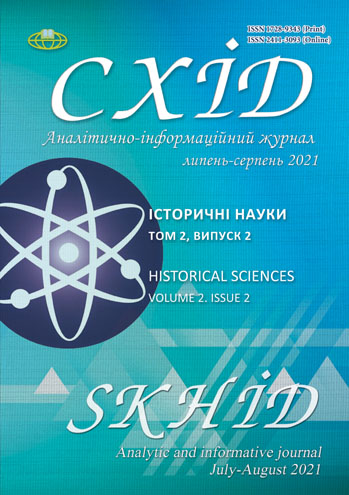THE STRUGGLE OF THE SOVIET AUTHORITY AGAINST THE «REMNANTS OF UNIAT» IN THE UKRAINIAN SSR AT THE BREAK OF THE 1970s – 1980s
DOI:
https://doi.org/10.21847/1728-9343.2021.2(2).239428Keywords:
Ukrainian SSR, Ukrainian Greek Catholic Church, western Ukrainian regions, The Communist Party of Ukraine, repressions, persecutions, believersAbstract
The key methods of the Ukrainian SSR party authorities to counter the attempts of reviving the Ukrainian Greek Catholic Church in the western Ukrainian regions at the break of the 80s-90s of the XX century were considered. It was noted that in the late 1970s in this region, particularly in Galicia, Greek-Catholic believers and the clergy measurably intensified their activity, which was evident mainly in houses of worship attendance, traditional rites observance, letters issued to the Council for Religious Affairs of the Soviet Union Ministers with the requirement to register religious communities, clandestine ordination of the clergy, etc. It was stated that in order to counter the religious influence intensification of the Russian Orthodox Church on the population, as well as to prevent negative anti-social manifestations of «remnants of Uniat», local Communist Party committees and Soviet authorities carried out a number of propaganda and mass political events to expose anti-Soviet religious ideology, in particular, «the reactionary role of the Uniat Church in the history of the Ukrainian people». It was noted that the Communist Party of Ukraine took concrete measures to step up anti-religious propaganda in Western Ukrainian regions, as well as to promote the advantages of the Soviet mode of life. It was alleged that the activities of Greek Ca¬tholic believers were discussed at the Council for Religious Affairs of the Soviet Union Ministers sessions of the Ukrainian SSR in the regions of Western Ukraine, party rallies at different levels, meetings of the ideological activists of the regions, seminars of cultural and educational wor¬kers, district and regional atheist conferences. It was noted that the Communist Party of Ukraine paid considerable attention to the media, which should have covered the historical aspects of the «anti-popular backbone of Uniat Church».
Downloads
References
Bazhan, O., Danyljuk, V. (2000). Vyprobuvannja viroju: borotjba za realizaciju prav i svobod virujuchykh v Ukrajini v drughij polovyni 1950-1980-kh rr. [The Test of Faith: The Struggle for the Realization of the Rights and Freedoms of Believers in Ukraine in the Second Half of the 1950s and 1980s]. Kyiv. (In Ukrainian)
Bondarchuk, P. (2012). Relighijna svidomistj virujuchykh URSR (1940-1980-i roky): povsjakdenni projavy, transformaciji [Religious consciousness of believers of the USSR (1940-1980s): everyday manifestations, transformations]. Kyiv. (In Ukrainian)
Central State Archive of the highest authorities and administration of Ukraine.
Marchuk, V. (2004). Cerkva, dukhovnistj, nacija. Ukrajinsjka ghreko-katolycjka cerkva v suspiljnomu zhytti Ukrajiny KhKh st. [Church, spirituality, nation. Ukrainian Greek Catholic Church in the public life of Ukraine in the twentieth century.]. Ivano-Frankivsjk. (In Ukrainian).
Pashhenko, V. (2002). Ghreko-katolyky v Ukrajini. Vid 40-kh rr. KhKh st. do nashykh dniv [Greek Catholics in Ukraine. From the 40's of the twentieth century. to this day]. Poltava. (In Ukrainian)
State Archives of Ivano-Frankivsk region.
State Archives of Lviv Region.
Vojnalovych, V. (2005). Partijno-derzhavna polityka shhodo relighiji ta relighijnykh instytucij v Ukrajini 1940 – 1960-kh rokiv: politologhichnyj dyskurs [Party-State Policy on Religion and Religious Institutions in Ukraine in the 1940s and 1960s: Political Science Discourse]. Kyiv. (In Ukrainian)
Downloads
Published
How to Cite
Issue
Section
License
Copyright (c) 2021 РОМАН ПУЙДА

This work is licensed under a Creative Commons Attribution-NonCommercial-NoDerivatives 4.0 International License.
1. Authors bear responsibility for the accuracy of facts, quotations, numbers and names used.
2. Manuscripts are not sent back.
3. The publisher does not always agree with the authors' opinion.
4. The authors reserve the right to authorship of the work and pass the first publication right of this work to the journal under the terms of a Creative Commons Attribution-NonCommercial-NoDerivatives 4.0 International License. This license allows others to distribute (copy) the published work for non-commercial purposes, provided there is mandatory attribution to its authors and a link to the first publication in our journal.
5. The authors have the right to conclude separate supplement agreements that relate to non-exclusive work distribution in the form in which it has been published by the journal (for example, to upload the work to the online storage of the journal or publish it as part of a monograph), provided that the reference to the first publication of the work in this journal is included.

